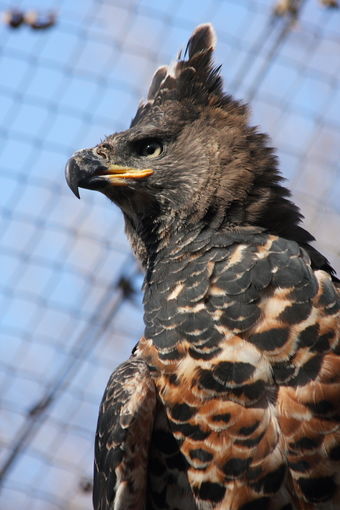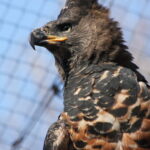The crowned eagle (Stephanoaetus coronatus) is a large bird of prey found in sub-Saharan Africa, known for its striking appearance and powerful hunting abilities. One of the most notable features of the crowned eagle is its impressive wingspan, which typically ranges from 1.51 to 1.81 meters (4 ft 11 in to 5 ft 11 in).
The Crowned Eagle’s Wingspan
The crowned eagle’s wingspan is relatively short for its size, with a wingspan-to-length ratio that is similar to that of a tawny eagle. This short wingspan is an adaptation for flying in the dense forests where the crowned eagle primarily hunts. The wings are broad and rounded, allowing for slow, maneuverable flight through the trees.
The largest authenticated wingspan for a female crowned eagle was 1.9 m (6 ft 3 in), with claims of wingspans up to 2 m (6 ft 7 in) needing confirmation. This impressive wingspan, combined with the eagle’s powerful build, makes it one of the largest and most formidable birds of prey in Africa.
Factors Influencing Crowned Eagle Wingspan
Several factors can influence the crowned eagle’s wingspan, including:
- Gender: Females typically have a larger wingspan than males, with the largest authenticated wingspan belonging to a female.
- Age: Younger eagles may have slightly smaller wingspans than older, more mature individuals.
- Habitat: Eagles living in dense forests may have slightly shorter wingspans than those in more open habitats, as the shorter wingspan is an adaptation for maneuvering through the trees.
- Individual Variation: As with any species, there can be natural variation in the wingspan of individual crowned eagles, even within the same population.
Comparison to Other Eagle Species
When compared to other eagle species, the crowned eagle’s wingspan is relatively short. For example, the bald eagle (Haliaeetus leucocephalus) has a wingspan ranging from 1.8 to 2.3 meters (5 ft 11 in to 7 ft 7 in), while the golden eagle (Aquila chrysaetos) has a wingspan of 1.8 to 2.34 meters (5 ft 11 in to 7 ft 8 in).
However, the crowned eagle’s short wingspan is an adaptation for its hunting style and habitat, and it is still one of the largest and most powerful eagles in Africa. Its weight, combined with its powerful talons and sharp beak, make it a formidable hunter capable of taking down prey as large as small antelope and monkeys.
Threats to the Crowned Eagle
Despite its size and power, the crowned eagle is not without its vulnerabilities. Its preference for hunting in dense forests makes it susceptible to habitat loss and fragmentation, and its slow reproductive rate (laying only one or two eggs every two years) makes it difficult for populations to recover from declines.
Deforestation, urbanization, and other human activities have led to a decline in the crowned eagle’s population in many parts of its range. Conservation efforts, such as habitat protection and sustainable forest management, are crucial to ensuring the long-term survival of this impressive bird of prey.
Conclusion
The crowned eagle is a remarkable bird with an impressive wingspan and powerful hunting abilities. Its short wingspan and heavy weight are adaptations for flying and hunting in the dense forests of sub-Saharan Africa, but these same adaptations also make it vulnerable to habitat loss and other threats. By understanding the unique characteristics of the crowned eagle’s wingspan, we can better appreciate the adaptations that allow this bird to thrive in its challenging environment and work to protect its future.
References:
- Info, A. (n.d.). Crowned eagle / Wingspan: 5 – 5.9 ft.
- Crowned Eagle | San Diego Zoo Animals & Plants. (n.d.).
- Crowned Eagle – Facts, Diet, Habitat & Pictures on Animalia.bio. (n.d.).
- Crowned Eagle – iSafiri. (n.d.).
- Crowned eagle – Wikipedia. (n.d.).
- Everything You Wanted to Know About the African Crowned Eagle. (n.d.).


